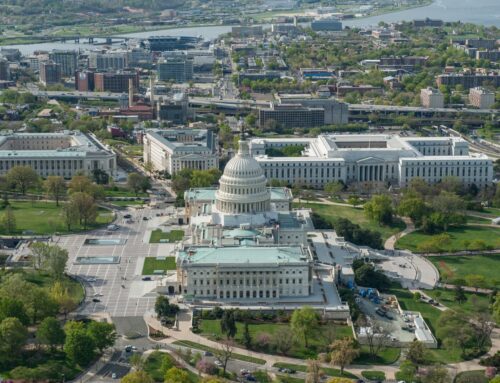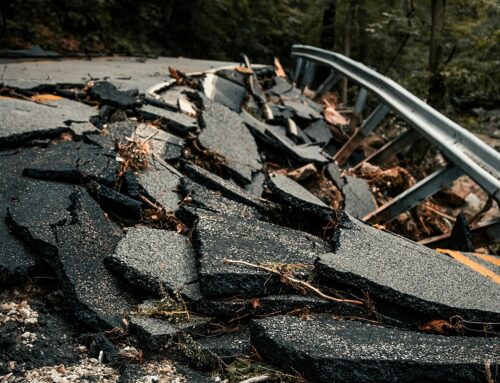View/Download this article in PDF format.
Update January 10, 2013:
We’ve combed through the House Appropriations Chairman Rogers Sandy Supplemental bill (HR 152 and his amendment to that) and Rep. Frelinghuysen’s amendment to the amendment to the bill. We’ve put it all the numbers together in a handy-dandy chart here. In addition, we’ve written up all the provisions that are in the Frelinghuysen amendment and how they would work. That’s available here. The bill is supposed to be on the floor Tuesday, and amendments are to be filed by Friday afternoon.
As far as the bill/amendment at hand, the upshot is that there are billions of dollars in spending that is not Sandy related. The amendment also strips out any local or state cost share for billions of dollars of Corps of Engineers projects – projects that were cost-shared in any previous disaster response. It also spends hundreds of millions of dollars on NOAA equipment that, while good to have to predict the next Sandy, are not emergency spending and should be budgeted. Which gets to the larger point. Out of one side of their mouth, lawmakers are saying that we need to deal with the across-the-board cuts that are sequestration and to reduce spending. Out of the other side of their mouth, they are calling a whole litany of regular spending items “emergency” to evade budget caps. We cannot afford business as usual. Business as usual got us into this $16.4 trillion debt hole, it’s sure not going to get us out of it.
A few elements of the bill:
- $25 million to improve weather forecasting and hurricane intensity forecasting (this should be in the regular budget)
- $1 million for DEA to repair or replace 15 vehicles as well as some technology (BATF gets $230K to replace three vehicles and some furniture). For the record, the Department of Justice has over 40,000 vehicles – this should come out of agency budgets, not emergency.
- $5.37 million for Army O&M to repair damaged facilities. This represents 0.01 percent of the Army’s FY12 regular O&M account (no war spending). I think a few sergeants could rummage through the couch cushions to come up with $5.37 million instead of emergency funding.
- $3.461 billion for Corps construction projects, $2.9 billion of which is for the Sandy region, and sand pumping on beaches would be at full federal expense. Normal cost-share (even in disasters like Katrina) is 65 percent federal, 35 percent local or state.
- $10 million for FBI salaries and expenses (this is more than double the $4 million requested by the President and in the previous Senate bill)
- $2 million for Smithsonian roof repairs
- $118 million for AMTRAK – $86 million more than the President requested and will be used on non-Sandy related Northeast Corridor upgrades
- $2 billion for Federal Highway Administration to spend on roads across the country (obviously not Sandy related)
- $16 billion Community Development Fund that would go to not only Sandy states but to any major disaster declarations of 2011, 2012, and 2013 (OH had the latest major disaster declaration on January 3, 2013 – for Sandy!). That encompasses 47 states and Puerto Rico. Want to know who’s left out? Sorry Arizona, Michigan, and South Carolina, thanks for playing. Maybe you’ll have a disaster later this year.
Everyone knows we have to enact Sandy disaster assistance for the those impacted. But we have to be sure we do it in an appropriate and effective manner. The Frelinghuysen amended Sandy supplemental isn’t riddled with “pork” per se, in fact in many ways it’s better than what the Senate passed last year. But far too much of it is not emergency and should be done in the context of the regular budget process. We cannot afford to fund our prevention, protection, and resiliency in slip-shod occasional emergency spending bills. Instead, it should be ingrained in the regular budget process.
Update January 8, 2013:
House Committee on Appropriations Chairman Harold Rogers (R-KY), has introduced Emergency Legislation for Hurricane Sandy Recovery. The bill, H.R. 152, provides nearly $17 billion in emergency, unpaid for, appropriations for a variety of programs. New Jersey Republican Congressman Rodney Frelinghuysen has proposed an amendment to H.R. 152 that would increase spending levels bringing them closer to those passed by the Senate in one of its final actions last year.
You can download a brief analysis comparing this bill with the President’s request, the Sandy Supplemental the Senate passed last year, and Congressman Frelinghuysen’s amendment.
Below is our analysis of the Senate spending bill. We will expand this to include House bill details as they are uncovered.
Originally Posted December 17, 2012
Sandy was a very intense and damaging storm and there is an important role for the federal taxpayer to aid those affected. But it is also critical that it be done in a limited and fiscally responsible way. Too often, lawmakers treat emergency spending as a honey pot for all their pet projects and initiatives. Considering that as part of the fiscal cliff the nation is facing nearly $110 billion in across the board cuts in 2013 alone, it doesn’t make sense to churn out a business as usual, wasteful $60 billion emergency supplemental stuffed with non-emergency funding.
Click here to see breakdown of Presidential and Senate amounts.
Here is a brief analysis of the Senate bill:
p. 3 Emergency Watershed Protection Program: $125 million for the Emergency Watershed Program, $77.085 million of which is for major disasters under the Stafford Act. In addition unobligated funds from the following 3 laws can also be used: Consolidated Appropriations Act of 2004 (additional money provided for wildfires in southern CA), Emergency Supplemental for Defense Appropriations and Hurricane Katrina from 2006, and Emergency Supplemental for Troops/Hurricane Katrina/Agriculture Disaster from 2007.
p. 5 National Oceanic and Atmospheric Administration: $373 million for operations, research, and facilities including $150 million for expense related to fishery disasters declared by Secretary of Commerce in 2012 (Includes: AK, MS, ME, NH, MA, RI, CT, NY). Spending plan required within 45 days from enactment. (Note: Could also include TX and American Samoa if it is for declarations made in 2012 rather than disasters in 2012 – language is unclear).
p. 6 $44.5 million for repair and upgrades of NOAA hurricane reconnaissance aircraft; $8.5 million for improvements to weather forecasting equipment and supercomputer infrastructure. Neither of these provisions is necessarily Sandy related.
p. 13 $1.31 million for Sandy-related roof repair at Radford Army Ammunition Plant (VA) paid for out of procurement of ammunition.
p. 13 $24.2 million for Defense Working Capital Funds for “expenses related to the consequences of Hurricane Sandy.” These are revolving funds and are supposed to be self-sustaining.
p. 14 $50 million for Corps of Engineers investigations, including $29.5 million to expedite and complete ongoing studies in Sandy-impacted areas in North Atlantic Division (ME to VA, cuts out NC); $20 million for an interagency planning process to address flood risk of vulnerable coastal populations, long-term sustainability to reduce economic costs and risks of large-scale flood and storm events; $500,000 to evaluate performance of existing corps projects impacted by Sandy, 120 days to complete (this means repair/reconstruction of projects will be undertaken before we know what and did not work). $10 million requested by the President for a flood vulnerability study first authorized in 2007 was rejected.
p. 15 $3.461 billion for construction, including: $2.902 billion for flood and storm damage reduction on Atlantic coast in NAD areas affected by Sandy; any project UNDER STUDY (note: this vague language means it could be for projects not currently being studied) that COST-EFFECTIVELY (not cost justified) reduce flood and storm damage risks is authorized (note: not restricted to Sandy area or at least vague); locals provide lands, easements, rights-of-way, relocation, and disposal (LERRDs); 90 percent federal cost-share; 30 year financing of cost-share from date of completion (normal is cost-share during construction – believe they did 30 year during Katrina); waives 902 of WRDA 86 that requires new authorization if project exceeds authorized cost by 20 percent; $499M can be transferred to other Corps of Engineers accounts to address previous natural disasters wherever with notice to approps w/in 15 days of transfer (normal cost share); $51 million to expedite Continuing Authority Projects in coastal areas in NAD impacted by Sandy (Note: this is double the amount of Continuing Authority Funding requested in FY13 for the entire country, also not restricted to flood/storm related CAPs); $9 million to repair projects under construction and damaged by Sandy; local interests pay 100 percent of operation & maintenance, repair, replacement, and rehab, only damages from fault or negligence of U.S. or contractors.
p. 18 $821 million for Operation & Maintenance funding to dredge federal channels and repair corps projects NATIONWIDE related to natural disasters (very likely to go to Mississippi River dredging in the St. Louis area). Typically, federal harbor dredging maintenance comes from the Harbor Maintenance Trust Fund (revenue from tax on the value of imports) which has a significant surplus.
p.19 $1.008 billion for flood control and coastal emergencies to prepare for natural disasters and support emergency operations (this is chronically underfunded account that is supposed to fix stuff after event without need for emergency supplementals); $430 million of the amount for projects in NAD impacted by Sandy, restore to design profiles of authorized projects (not just to pre-Sandy levels but to design); 20 percent cap on cost overruns in excess of authorized levels waived; monthly report.
p. 20 $10 million for Corps “expenses” to oversee emergency response and recovery activities related to natural disasters (not Sandy-specific).
p. 21 $40 million for Small Business Administration, including: $20 million for grants or cooperative agreements with organizations to provide technical assistance to disaster recovery, response, and long term resiliency to small businesses affected by Sandy; $20 million for grants or cooperative agreements for public private partnerships for LONG-TERM economic development assist to industries or regions affected by Sandy, includes economic development initiatives such as innovation clusters, industry accelerators, supply-chain support, commercialization, and work force development (these may be good ideas but are not emergency); grants and cooperative agreements only to current recipients of SBA grants and cooperative agreements; WAIVES MATCHING REQUIRMENTS under 21a4a and 29c of Small Business Act.
p.24 $500 million for SBA disaster loans available until expended, additional $260 million for loan making and servicing expenses which can be merged with Salaries and Expenses approps, $10 million is for indirect administrative expenses.
p.24 Section 411(a)(1) of Small Business Act of 1958 amended by striking $2 million and inserting $5 million. (increases surety bond guarantee)
p.25 changes rules in Small Business Act to allow small business owner use assets other than primary residence of owner as collateral for loans under $200,000.
p. 26 All the Department of Homeland Security salaries and expenses provisions require the agencies to submit a description of all property replaced to approps in 90 days. TCS will FOIA each agency for this list.
p.28 Disaster Relief Fund $11.487735 billion available until expended; $5.379 billion for major disasters under Stafford act (not Sandy designated) disaster relief under Balanced Budget and Emergency Deficit Control Act of 1985 section 251(b)(2)(D); $6.108735 billion for major disasters under Stafford act (not Sandy) under BBEDCA of 85 section 251(b)(2)(A)(i) (I’M NOT SURE OF THE DIFFERENCES BETWEEN THESE TWO SECTIONS); $3M for IG for audits and investigations (Note: normal to not have Disaster Relief Funding not Sandy, it’s for current and future disasters)
p. 29 $300 million for Disaster Assistance Direct Loan Program account available until expended; $4 million for administrative expenses; funds subsidize gross obligations for principal of direct loans not to exceed $400 million.
p.31 Increase National Flood Insurance Program borrowing authority from $20.725 billion to $30.425 billion (+$9.7 billion) effective Dec. 12 2012; FEMA can give greater weight to factors in 206.48(b)(3) of title 44, CFR (deals with low-income, elderly, under-employed, American Indian, or Alaska Native Tribal) to accurately measure the needs of a population following a disaster to expedite declaration of individual assistance under Stafford act.
p.32 FEMA can recommend increase in federal share (generally 75 percent) of permanent work under 406 (Repair, Restoration, and Replacement of Damaged Facilities) and emergency work under 403 (Essential Services) and 407 (Debris Removal) of Stafford Act. (Note: Earlier this year the DHS IG found that the 100 percent federal share for FEMA projects post-Katrina have resulted in long delays in completion by removing incentives).
p.32 Section 5605 – major disasters between 8/27/11 and 12/5/12 (begins with Hurricane Irene declarations and could encompass at least 30 states, Puerto Rico, and DC flooding declarations) and or subsequent declaration from Sandy FEMA establish pilot program for relocation of state facilities where FEMA can fund under 406 of Stafford permanent relocation of significantly disaster damaged state facilities subject to flood risk, includes admin office buildings, medical facilities, laboratories, and related operating infrastructure. Must be more cost effective than repair and would mitigate flood risk. Note: this interrelates with the previous provision that enables FEMA to increase federal share of these projects.
p.33 Sec. 5606 – This provision is essentially a modified version of a S. 2039 (Hoeven) which was rejected by the House 126-254 in July (it passed the Senate quietly under unanimous consent in January 2011). This provision is exactly counter to smart floodplain management and should not be in an emergency supplemental spending bill. It is a policy change (and a bad one at that) and it was rejected soundly by the House. The original bill was intended to let towns in ND build levees on flooded lands that were bought by FEMA from willing sellers. Any land purchased under the program has a permanent easement preventing any development (makes sense, why buyout a flooded structure to let another one be built). This provision would gut the program by letting any “Midwest” (undefined) state with a 2011 flood declaration build a levee on buyout land – that’s the change, it was previously just North Dakota. The buyout could have happened years ago or some future buyout ten years from now. It completely guts the program, at least in KS, IA, NE, MO, MN, OH, IN, IL, OK, ND, WI (10 states with 2011 declaration that could possibly be construed as Midwest). This would create a system where the federal government would purchase frequently flooded land only to turn around and find the purchase subsidizing levee construction (land acquisition is typically the most expensive part of levee construction) and floodplain development.
p. 34 Sec. 5607 – Directs FEMA to reopen its loan cancellation review process and broaden its ability to cancel loans for communities affected by Hurricane Katrina and other 2005 hurricanes. The same provision was passed out of the Senate Appropriations Committee this year as part of the DHS appropriations bill, but a similar provision was not included in the House version. A total of $1.04 billion is available in direct loans through several previous bills. In 2005, $750 million was provided in direct loans, but Congress added an additional $280 million in 2006. Each loan can exceed $5 million, although prior law (Stafford Disaster Relief and Emergency Assistance Act) required loans to be under $5 million.
It would (for the first time) allow both disaster-related and debt service expenses to reduce local governments’ revenue totals, resulting in a greater possibility that municipalities fail to meet their operating budgets and thus qualify for federal loan cancellations. The FEMA Administrator would be able to cancel loans if local government revenues fail to meet operating budgets in a 3-, 5-, or 7-year period after the disaster, while prior law allowed cancellation only if revenues failed to meet budgets over a 3-year period.
Finally, and potentially the most troubling provision, indicates that communities which have managed to repay their federal loans, including interest, can be reimbursed for the cost of these payments. This section applies to loans provided under bills mentioned above. According to CRS, this includes “approximately $28.2 million in principal and interest that local governments have already repaid to FEMA.”
p. 37-66 Disaster Recovery Act of 2012 (this is modified version of the Landrieu/Cochran S. 1360 Disaster Recovery Act of 2011 which was introduced more than a year ago and has not been considered by the Committee on Homeland Security and Governmental Affairs. This type of policy changes – even if appropriate – should not be part of the emergency supplemental.
- p.37 Streamlining added to Stafford Act; advance assistance of 25 percent anticipated hazard mitigation measures
- p.40 Whole new public assistance program alternative procedures section added to Stafford act. May make sense but should be done in comprehensive way and by authorizing committees not approps.
- p. 48 more policy change “unified federal review” on environmental and historic requirements under federal law for disaster recovery.
p. 68 $150M for Interior expenses related to Sandy or other activities related to storms and natural disasters avail until expended; funds to restore and rebuild parks, refuges, public assets; increase resiliency of coastal habitat and infrastructure; protect natural and cultural values; this money can go anywhere in the department (seems like a slush fund)
p. 69 $5M for Leaking Underground Storage Tank trust fund.
p.70 $810M for EPA state and tribal assistance grants; $700M for Clean Water SRF; $110M for Drinking Water SRF; only to states with Sandy disaster declaration; no eligible state gets less than 2 percent of the funds; matching and cost-sharing requirements waived; states use at least 50 percent of funds provided for additional subsidization in form of forgiveness of principal, negative interest loans or grants; only for eligible projects to reduce flood damage risk and vulnerability or increase resiliency to “rapid hydrologic change” or natural disaster at treatment works; EPA gets $1M of funds for management.
p. 74 $500M to HHS Social Services Block Grant for Sandy disaster states; increases uses of funds from those permitted under Title XX of Social Security Act to include health services (including mental health services), and costs of renovating, repairing, or rebuilding health care facilities (including mental health facilities), child care facilities, and other social service facilities; states can use up to 10 percent to supplement funds for payments to health care providers for lost wages from Sandy, payments to support the viability of health care providers with facilities substantially damaged by Sandy; funds are available costs incurred up to 3 days prior to the 10/29/12 landfall; no funds used for FEMA reimbursable costs
p.76 $100M for Head Start in Sandy disaster states, funds available through 9/30/14; can be used on services or facilities damaged by Sandy.
p. 81 $207M for VA construction to renovate and repair VA Medical Center in Manhattan from damage caused by Sandy; can be used for planning and design and major medical facility construction not authorized by law
p. 81 $30M derived from Airport and Airway Trust Fund (so not general revenues) for Sandy expenses
p. 82 $921M for federal-aid highways (does not appear to be trust fund related)
p. 83 $10.8 billion to the Federal Transit Administration (the President’s proposal provides FTA $11.7 billion). This money will not be spent immediately, as most would expect “emergency” funding to be doled out. Instead, according to the Congressional Budget Office analysis, only 15% of the funds would be spent by the end of fiscal year (FY) 2014, with the remainder spent between FY15 and FY22. CBO estimates that more than one-quarter of the FTA funds would not be spent until FY19 (six years from now) or later.
By comparison, of the $921 million the Senate provides for Highway Emergency Relief (above) to the Federal Highway Administration (a dramatic increase from the $308 million provided in the President’s proposal), 42% will be spent by the end of FY14; only 11% will be spent in FY17 and FY18 combined; and none of the spending occurs in FY19 or later.
p. 82 $336M $336 million to the Federal Railroad Administration for Amtrak-related expenses, more than ten-times the $32 million the President has proposed. Of particular concern is that an estimated $188 million of this money is for design and engineering work related to Amtrak’s Northeast Corridor Gateway project, a long-term $14.6 billion project to decrease the bottleneck between Newark, New Jersey and New York City and increase train speed in the Northeast. This project, and the search for funding for it, was on the table long before Sandy slammed the Northeast, and has no place in an emergency bill that is intended to repair and replace what was lost during Sandy.
p. 84 $17B for HUD community development fund avail until expended; $2B for mitigation to reduce future risk and vulnerabilities; minimum allocation for each Sandy state set by secretary; $100M for unmet needs of impacted areas from major disaster in 2011 or 2012 (research this); at least 33 percent allocated to grantees w/in 60 days of enactment; grantees submit plan for fund use prior to allocation about how will address long-term recovery; cannot be used on FEMA reimbursable activities; Includes clause (“Final paragraph under community development block grants in Title II of PL 105-276 (42 USC 5305 Note) shall not apply to funds under this heading”) that allows funds to be used to cost-share Corps of Engineers projects; grantee can use up to 5 percent funds for overhead; bunch of waiver stuff; cannot spend less than 50 percent on activities that benefit low and moderate income persons; $10M to IG
p.90 Approps has to be notified at least 3 business days before award of grant of $1M or more by Transportation or HUD
p. 91 Agencies submit internal control plans for funds to OMB and Approps by 3/31/13
p. 92 Grantees return agency funds not expended within 24 months
For more information contact Steve Ellis, 202-546-8500 x126 or steve(at)taxpayer.net













Get Social